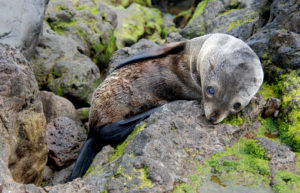Fur Seals of Isla Guadalupe
By Staff Veterinarian, Dr. Lorraine Barbosa
This March, I had the amazing privilege of traveling to Isla Guadalupe, a small island off the coast of Baja Mexico, and the primary place in the world where the ESA-listed Guadalupe fur seal breeds. I traveled with a team of scientists from the Centro Interdisciplinario de Ciencias Marinas (CICIMAR-IPN), Sonoma State University, and The Marine Mammal Center, whose research topics included general health assessments, satellite tagging, investigation of environmental and handling stressors, and my project- anesthesia parameters.

Guadalupe fur seals are on the Endangered Species Act list and considered threatened. Photo by Lorraine Barbosa
We traveled first by car to Ensenada, Baja California, Mexico, then by 22hr boat ride to the small volcanic island located 250mi into the vast desolation of the Pacific Ocean. Each morning we made a short trek to the fur seal rookery, a long rocky outcropping where waves whipped against the shores and tides ruled our daily routine. There, we were surrounded by the wailing cries of adult females arriving to the rookery from foraging trips, calling back and forth to their bleating pups until they reunited. The young pups whose mothers were away played and jughandled carefree in the tidepools, while the older pups, who for the most part were plump and healthy, sunned themselves on the rocks before heading off into the ocean on their own adventures.
We rotated between catching pups and adult females, overall anesthetizing 15 seals during our stay. Catching the pups was relatively simple: sneak up and grab them with a net while they slept. Catching the adult females took a bit more finesse. They were much more alert and skittish. One had to spend time sneaking up on them, taking small crouched steps forward each time they closed their eyes for just a moment, and pretending to be disinterested in them each time they opened their eyes to reassess our proximity. Once close enough, one had to quickly net the 55kg of unruly muscle and retain her until the others arrived to help. A face mask was then applied, and Isoflurane gas anesthesia was delivered until the seal slipped into unconsciousness. Once asleep, each researcher set out collecting samples for their various research projects. Meanwhile, I monitored heart rate, respiratory rate, and other vital parameters, ensuring the animal was maintained at a proper level of anesthesia. In the evenings we would assemble in our makeshift living room laboratory, all working together to process the day’s samples, until the electricity would go out at 10pm. The anesthesias progressed smoothly and quickly, and before we knew it, so had our time on the island. As we departed on our final day, the rookery again becoming engulfed by the sounds of the thrashing waves and the howling cries of the fur seals, I knew how lucky I was to have had such an incredible experience, and that I would do it all over again in a heartbeat.
All activities were conducted under permits (DGVS/00050/16) issued to Dr. Fernando Elorriaga Verplancken (CICIMAR-IPN) by the Mexico Secretaría del Medio Ambiente y Recursos Naturales (SEMARNAT) and Comisión Nacional de Áreas Naturales Protegidas (CONANP)-Reserva de la Biósfera Isla Guadalupe.
